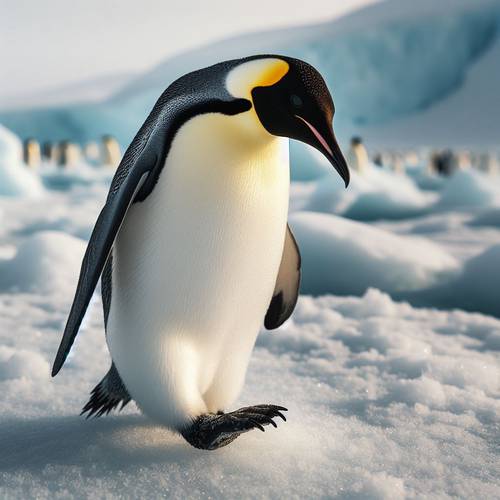Penguin Menu
Ever wonder what a penguin gobbles down for dinner? I mean, they live in a pretty chilly neighborhood. It's not like there are pizza delivery guys waddling around the South Pole!
Penguins might look cute and cuddly, but they're actually super skilled hunters! Their tummies rumble for meat, making them carnivores of the icy seas.
Fish: The Penguin's Staple Food
- Primary food source for most penguin species
- Favorite fish include small, silvery varieties like anchovies and sardines
- Consumption varies by penguin species and size
- Example: A Gentoo penguin can consume over 4.5 pounds (2 kg) of fish daily
- Penguins perform underwater acrobatics to catch fish
Krill: Energy-Packed Snacks
- Tiny shrimp-like creatures, rich in energy
- Penguins can eat 1-2 pounds (0.45-0.9 kg) of krill per day
- Especially important during nesting season
- Baby penguins can consume over 2 pounds (0.9 kg) of krill daily while growing
Squid: The Deep-Sea Delicacy
- Penguins dive up to 150 feet (45 meters) or more to catch squid
- Use sharp beaks to consume squid
- Larger species like Emperor penguins rely heavily on squid
- An Emperor penguin can eat over 3 pounds (1.36 kg) of squid in one feeding session
Other Prey: Variety in the Diet
- Occasionally consume jellyfish and other small sea creatures
- Little penguins can eat over 100 small crustaceans (crabs, amphipods) daily.
Next time you see a picture of a penguin, think about the amazing meals they're catching beneath the waves. They're true survivors with a taste for the tastiest treats the ocean has to offer!
Prefered food by species !
1. Emperor Penguins: Primarily fish (especially Antarctic silverfish), also squid and krill
2. King Penguins: Mainly lanternfish and squid
3. Adelie Penguins: Mostly krill, also small fish and squid
4. Gentoo Penguins: Various fish species, squid, and krill
5. Chinstrap Penguins: Primarily krill, some small fish
6. Macaroni Penguins: Mostly krill, also small fish and squid
7. Rockhopper Penguins: Krill, small fish, and squid
8. African Penguins: Anchovies, sardines, and other small pelagic fish
9. Galapagos Penguins: Small fish like mullet and sardines
10. Little (Fairy) Penguins: Small fish such as anchovies and sardines!
Penguins might look cute and cuddly, but they're actually super skilled hunters! Their tummies rumble for meat, making them carnivores of the icy seas.
Fish: The Penguin's Staple Food
- Primary food source for most penguin species
- Favorite fish include small, silvery varieties like anchovies and sardines
- Consumption varies by penguin species and size
- Example: A Gentoo penguin can consume over 4.5 pounds (2 kg) of fish daily
- Penguins perform underwater acrobatics to catch fish
Krill: Energy-Packed Snacks
- Tiny shrimp-like creatures, rich in energy
- Penguins can eat 1-2 pounds (0.45-0.9 kg) of krill per day
- Especially important during nesting season
- Baby penguins can consume over 2 pounds (0.9 kg) of krill daily while growing
Squid: The Deep-Sea Delicacy
- Penguins dive up to 150 feet (45 meters) or more to catch squid
- Use sharp beaks to consume squid
- Larger species like Emperor penguins rely heavily on squid
- An Emperor penguin can eat over 3 pounds (1.36 kg) of squid in one feeding session
Other Prey: Variety in the Diet
- Occasionally consume jellyfish and other small sea creatures
- Little penguins can eat over 100 small crustaceans (crabs, amphipods) daily.
Next time you see a picture of a penguin, think about the amazing meals they're catching beneath the waves. They're true survivors with a taste for the tastiest treats the ocean has to offer!
Prefered food by species !
1. Emperor Penguins: Primarily fish (especially Antarctic silverfish), also squid and krill
2. King Penguins: Mainly lanternfish and squid
3. Adelie Penguins: Mostly krill, also small fish and squid
4. Gentoo Penguins: Various fish species, squid, and krill
5. Chinstrap Penguins: Primarily krill, some small fish
6. Macaroni Penguins: Mostly krill, also small fish and squid
7. Rockhopper Penguins: Krill, small fish, and squid
8. African Penguins: Anchovies, sardines, and other small pelagic fish
9. Galapagos Penguins: Small fish like mullet and sardines
10. Little (Fairy) Penguins: Small fish such as anchovies and sardines!



